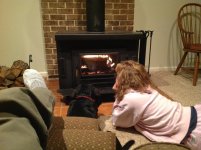ritmatt
Member
I recently bought a house that included a wood stove. The house and, presumably, the stove are about 25 years old. The stove has two small intake vents on the front, but there is no damper in the flue. All of the wood stoves I've ever used have included flue dampers, which have been instrumental in slowing down the burn rate of the wood fuel and heating the stoves. Also, after burning wood in my stove once, the room it's in smelled like burnt wood for days afterwards. I think the absence of a flue damper allowed wind to blow the smell back through the not-so-airtight intake vents and into the room.
Are some stoves designed to be used without flue dampers? Is there any harm in adding one to my wood stove?
Are some stoves designed to be used without flue dampers? Is there any harm in adding one to my wood stove?

